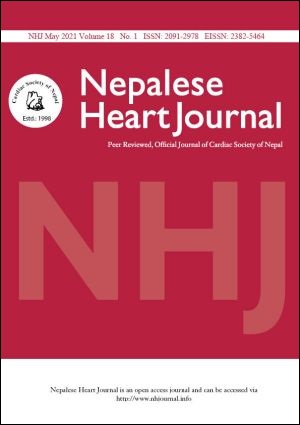Efficacy and Safety of Focal Atrial Tachycardia and Typical Atrial Flutter Ablation in Nepal-A Single Center Experience.
DOI:
https://doi.org/10.3126/njh.v18i1.36776Keywords:
Cavotricuspid Isthmus Dependent Flutter, Focal Atrial Tachycardia, Typical Atrial FlutterAbstract
Background and Aims: Atrial tachycardia is classified as focal atrial tachycardia or macro-reentrant atrial tachycardia. Macro-reentrant atrial tachycardia involves large circuit and is also called atrial flutter in which cavotricuspid isthmus dependent flutter, also called typical atrial flutter is the most common. The aim of this study is to report the efficacy and safety of catheter ablations of these arrhythmias, for the first time in Nepal.
Methods: This is a retrospective observational study of the patients who underwent electrophysiological study with ablation for focal atrial tachycardia and typical atrial flutters at Shahid Gangalal National Heart Center (SGNHC) from March, 2015 to February 2020.
Results: Altogether, 49 patients, 27 for focal atrial tachycardia and 22 for typical atrial flutter, underwent electrophysiology study with intent to ablation. In two patients, atrial tachycardia could not be induced, therefore 25 patients underwent ablation for atrial tachycardia. Out of 25 patients, the successful ablation achieved in 24 patients (96%) with recurrence in three patients (12%), with no major complications. Atrial tachycardia more commonly originated from right atrium than the left atrium (68% vs. 32%). Among 22 patients who underwent cavotricuspid isthmus ablation for typical atrial flutter; successful ablation achieved in 21 patients (95%) with recurrence in two patients (9%) and a single case of access site hematoma. Counterclockwise flutter was found to be more common than clockwise flutter (91% vs. 9%).
Conclusion: In SGNHC, the ablations of focal atrial tachycardia and the typical atrial flutter has a high success and low complication rate.
Downloads
Downloads
Published
How to Cite
Issue
Section
License
This license enables reusers to distribute, remix, adapt, and build upon the material in any medium or format, so long as attribution is given to the creator. The license allows for commercial use.




